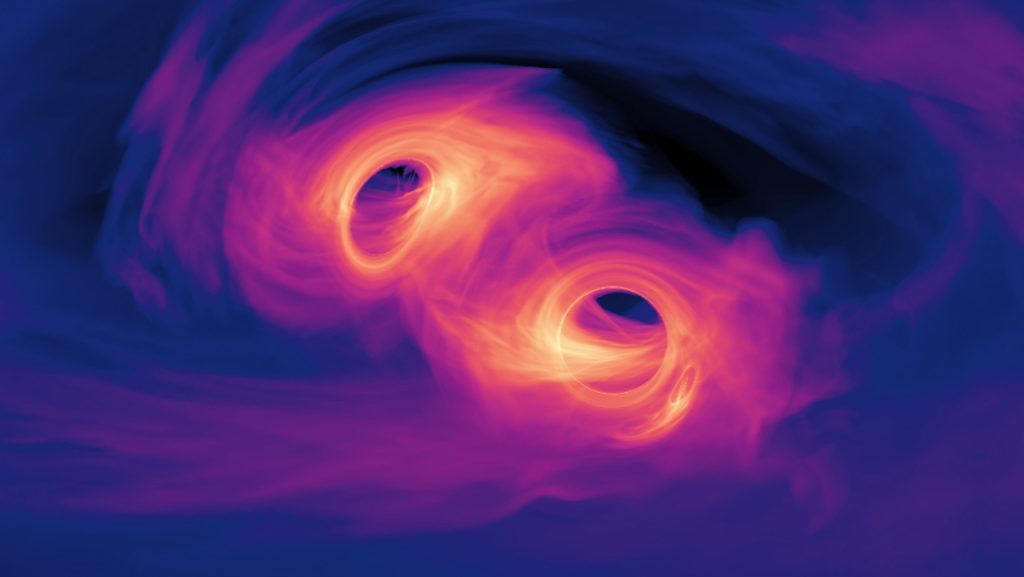Black Holes and Space: Can Black Hole Mergers Reveal Hawking Radiation?
Key Takeaway
A new theory suggests that tiny black holes, called “morsel” black holes, created during the merger of larger black holes might be the key to finally detecting Hawking Radiation.
Summary
- Hawking Radiation is a theory that black holes emit radiation over long periods of time, but it has never been observed.
- Researchers believe that black hole mergers may create small black holes called “morsel” black holes.
- The Hawking Radiation from these morsel black holes is predicted to be much stronger and easier to detect due to their small size.
- This radiation would produce a specific kind of gamma ray burst with high-energy photons.
- Existing telescopes like HAWC Gamma-ray observatory might be able to detect these gamma rays.
- Some challenges remain, such as the morsel black holes’ environment during emission potentially affecting the radiation and limitations in our understanding of physics at high energies.
- If detected, this Hawking Radiation could reveal new physics beyond our current knowledge.
- The existence of these morsel black holes themselves could also be a sign of dark matter, leftover from the early universe.

Black Hole Burps: Could Tiny Holes Finally Reveal Hawking Radiation?
Black holes are enigmatic giants, warping spacetime with their immense gravity and shrouding themselves in an event horizon, a point of no return for even light. One of the biggest mysteries surrounding them is Hawking Radiation, a theory proposed by Stephen Hawking in the 1970s. This theory suggests that black holes, despite their immense gravity, slowly leak energy and particles over vast stretches of time, eventually evaporating entirely.
The problem? Hawking Radiation is incredibly weak, especially for stellar-mass black holes, making it nearly impossible to detect directly. Here’s where things get interesting. A recent study published in a paper titled “Measuring Hawking Radiation from Black Hole Morsels in Astrophysical Black Hole Mergers” proposes a fascinating new way to observe this elusive phenomenon.
The study hinges on the idea of “morsel” black holes, theorized tiny black holes created during the violent mergers of larger black holes. These mergers, first predicted and then confirmed through gravitational wave detections, are incredibly energetic events. Researchers believe that these mergers might also eject a number of these morsel black holes, some as small as asteroids.
The key here is size. Because Hawking Radiation is inversely proportional to mass, these tiny black holes would emit Hawking Radiation at a much stronger rate compared to their larger counterparts. This stronger radiation is predicted to manifest as a specific kind of gamma-ray burst with high-energy photons.
The good news? Existing gamma-ray telescopes like the HAWC Gamma-ray Observatory might be powerful enough to detect these unique gamma-ray signatures. This opens up a new window for finally observing Hawking Radiation and validating a cornerstone of theoretical physics.
However, there are still challenges to overcome. The intense gravitational environment during a black hole merger could affect the Hawking Radiation emitted by the morsel black holes. Additionally, our current understanding of physics at extremely high energies might have limitations, making it difficult to precisely predict the radiation’s characteristics.
Even with these challenges, the prospect of detecting Hawking Radiation is a scientific game-changer. Not only would it confirm a major prediction by Stephen Hawking, but it could also shed light on new physics beyond our current knowledge. The study mentions that the properties of the gamma-ray bursts could reveal new forces or particles not yet accounted for in the Standard Model.
The existence of the morsel black holes themselves is also intriguing. Some researchers speculate that these tiny black holes, leftovers from the early universe with different physical conditions, could be a form of dark matter, the mysterious substance that makes up a significant portion of the universe’s mass.
The ongoing quest to understand black holes might soon yield groundbreaking discoveries, with these tiny morsel black holes playing a crucial role in unveiling the secrets of Hawking Radiation and the fundamental nature of the universe.
Sources:
- CERN (European Organization for Nuclear Research): “Supersymmetry.” Available at: https://www.home.cern/science/physics/supersymmetry
- Department of Energy: “The Standard Model of Particle Physics.” Available at: https://www.energy.gov/science/doe-explainsthe-standard-model-particle-physics
- HAWC Observatory: Available at: https://www.hawc-observatory.org/
- Wikipedia: “Hawking radiation.” Available at: https://en.wikipedia.org/wiki/Hawking_radiation
- ArXiv: “Title of the paper.” Available at: https://arxiv.org/abs/2405.12880

